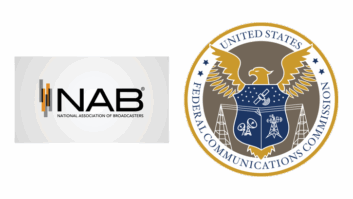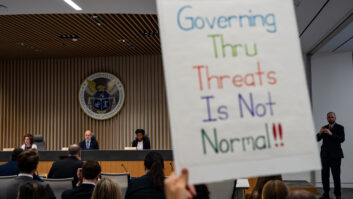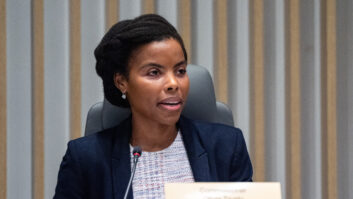The FCC’s proposal of a new formula to determine which radio stations can use the highest allowable digital FM power levels is very popular among major U.S. broadcast groups.
Cumulus, Audacy, Beasley and others are rallying behind the effort to boost HD power levels, and also support a companion request to allow asymmetric sideband power levels. The twin petitions were combined in one proposal by the FCC for consideration.
Xperi, the developer and licensor of HD Radio technology, and the National Association of Broadcasters said approving the requests would be in the public interest. There are approximately 2,600 FM radio stations using HD Radio in the U.S., according to Xperi.
The proposal, which would permit additional stations to increase FM hybrid digital effective radiated power beyond existing levels without need for individual commission authorization, also has the backing of iHeartMedia, the largest U.S. radio group.
The commission’s in-band, on-channel ERP formula with its current limit of -14 dBc for most stations has long been too conservative, iHeart told the commission. The FCC should allow increases of digital FM power up to -10 dBc, or 10 percent of analog power, for more stations, it wrote.
The radio broadcaster also believes FM digital stations should be permitted to operate with asymmetric power on digital sidebands. iHeart said the proposals “are grounded in hard data from comprehensive engineering analyses, field studies and years of real-world digital operations.”
Joint comments from Beasley and Audacy encourage the FCC to move forward. “Adoption of the commission’s proposals will allow radio broadcasters to transmit more robust, high-quality, digital FM signals without the frustrating dropouts and poor building penetration that currently plague HD Radio,” they wrote.
The two companies said the changes could encourage more broadcasters to provide digital offerings, which ultimately will benefit the listening public. “Consumers will benefit from increased access to multiple streams of innovative and diverse free local programming including specialized and localized news, weather, sports, public affairs and entertainment, combined with rich metadata textual and graphical information like traffic, special events, and music information and artwork,” Audacy and Beasley wrote.
[Related: “FCC Advances FM HD Power Proposal“]
Several radio groups also address the commission’s interference mitigation and remediation processes. Cox Media Group, which participated in field tests detailed in the power increase petition, contends the potential for new interference is minimal but still encourages the FCC to move cautiously.
“Even though the power increases are very unlikely to cause new harmful interference, CMG nevertheless supports the commission’s conclusion that current interference mitigation and remediation procedures can and should be used in the unlikely event that new interference occurs,” Cox wrote to the FCC.
Elsewhere, Cumulus supports all aspects of the FCC’s NPRM. It goes further to recommend the commission implement a supplementary step of providing “a centralized record containing information on stations that have increased digital power under the revised rules.”
Cumulus continued: “Although relatively few analog FM stations have filed interference complaints from adjacent-channel digital operations causing interference, Cumulus respectfully submits that the commission should take measures that facilitate identification of the sources of interference.”
National Public Radio, a joint petitioner with Xperi and NAB in the asymmetric sideband proporal, told the FCC in its most recent comments that it supports a request for an increase in power levels in general, but it would like to see “a robust notification method, such as direct notifications to adjacent stations, that would protect the adjacent stations by allowing them to watch for and quickly identify any new interference caused by the digital sideband power increase.”
Further, NPR said it is not asking that adjacent neighbors be provided a mechanism for objecting to a digital power increase. “Instead, NPR believes that a pre-notification would help an adjacent station to be prepared to quickly identify interference after a digital power increase.”
In its proposal, the FCC also addressed superpowered FM stations. It tentatively proposed that a superpowered FM station’s digital ERP should continue to be limited to the class maximum. The commission concluded that a “superpowered FM station seeking to increase its digital power above -14 dBc would need to request experimental authorization or special temporary authorization for commission staff review on a case-by-case basis.” Super-power FMs are defined by the FCC as stations that have been grandfathered to allow higher power-level operation than typically allowed for its class. On background, there are about 60 Superpowered FM stations in the country, most of which are Class B.
iHeartMedia thinks superpowered FMs should be allowed to calculate digital power based on actual ERP — using the revised IBOC formula in order to maximize efficient spectrum use while maintaining the same interference protections to their neighbors through the interference remediation process.
“A more restrictive approach for superpowered FM stations would unduly hamper FM digital radio service by such stations, which are subjected to the same digital performance and coverage issues as class-standard stations,” it wrote.
[Related: “For HD Radio, Use the Maximum Authorized Power“]
While large broadcast groups press the FCC to move forward with the technical changes to improve HD Radio, at least one LPFM noted in its comments how the proposal will widen the gap between the have and have-nots of the broadcast world.
Santiam Community Radio Corp., licensee of KPIK(LP) in Stayton, Ore., told the FCC the cost of implementing the technology and ongoing licensing fees makes entry to digital radio impossible for the vast majority of LPFM stations.
“We have been informed by broadcast equipment suppliers to budget between $40,000 and $50,000 for the additional necessary equipment, engineering and licensing fees. This represents many times annual revenues received from underwriting and other donations. Even if funds were available, it is a questionable expenditure for stations with limited coverage and smaller population.
“The initial outlay for digital sideband exciters, antenna combiners, GPS synchronization and other equipment may quadruple the expenditure in equipment for a typical analog LPFM or even a Class-A full-power station,” Santiam told the FCC.
Santiam said it is aware of no more than a handful of LPFM stations nationwide operating in digital FM.
The deadline for comments about the proposal has passed, but the deadline for reply comments is Oct. 6. Refer to MB Docket No. 22-405.






